12 May 2024
Card Buddy/Bread Book/Pocket Translator
Recomendo - issue #409
Sign up here to get Recomendo a week early in your inbox.
Draggable index cards
I’ve tried using mind maps and Kanban board tools for brainstorming and organization, but they often become overwhelming. So far, I am very satisfied with the minimalist Card Buddy app, which is incredibly intuitive. I didn’t need to learn anything new to start using it. You can create an infinite canvas, drag around cards, drop in images, and customize the layout, style, and colors. It requires a one-time payment of $20 and is available exclusively on Mac and iOS. — CD
Ultimate home bread
If you have any interest in baking bread at home, check out this nerdy, obsessive, gigantic tome, Modernist Bread At Home, by Nathan Myhrvold. Sure, you can find bread recipes online, but this is different. Every possible type of bread in the known world, in all possible variations, tested through all manner of mistakes, are clearly illustrated. There are two volumes ($120), one with astounding images and one spiral bound for the kitchen with recipes, but the two are actually a digest distillation of a larger ultimate 5-volume set aimed and recalibrated for the home. This reference is very good for giving you enough guidance to try new kinds of bread you would not have tried making before. Not every home baker will need this level of expertise, so check it out at your local library. — KK
Pocket translator that works
This recommendation comes from my friend, Charles Platt, who purchased a translation device called PockeTalk for an upcoming trip to Japan and found it to be “amazing.” He said the phone-sized gadget is “does a voice-to-text conversation, then translates the text (you see it on the screen) and speaks it in a lifelike voice. It also has character recognition. It is intended for menus and street signs, but I gave it the back cover blurb of the Japanese edition of a book of mine, and even though the text was bold and in a weird color, it gave a very good conversion. It requires internet access but is preloaded with 2 years of credit for phone systems all over the world, and can also use WiFi. After 2 years, you pay $25 per year for global phone access. I tried a $75 translator last year, which was awful. This one is $300 [cheaper on Amazon] but much more than 4 times as good.” — MF
Cat cameras
For an instant oxytocin boost, I’ve been visiting meow.camera to watch livestreams of cute, hungry cats eating. The webcams, attached to automatic feeders, only activate when a viewer is watching. It’s surprising how much happiness this brings me! You can favorite specific feeders and come back anytime to check in your furry friends. — CD
Music generating AI
After years of crummy AI-generated music apps, there are now several music generators that are worth spending time with. I’ve been staying up late at night tweaking prompts to make complete songs using Suno. Just like using an image generator, I give Suno a wordy description of the song, mood, beat, that I am looking for, and it generates a very listenable song, with pretty good lyrics, bridges, choruses, and album cover art! The free version of Suno gives you 10 songs per day, maxed out at 2 minutes per track. I use these as soundtracks for video shorts. There are a couple other recent apps, but I like Suno the best and will pay for a subscription. It is good enough for anyone to try out. — KK
How to criticize something you disagree with
Here are social psychologist Anatol Rapoport’s rules for criticizing something:
- You should attempt to re-express your target’s position so clearly, vividly, and fairly that your target says, “Thanks, I wish I’d thought of putting it that way.”
- You should list any points of agreement (especially if they are not matters of general or widespread agreement).
- You should mention anything you have learned from your target.
- Only then are you permitted to say so much as a word of rebuttal or criticism.
Via Intuition Pumps And Other Tools for Thinking, by Daniel C. Dennett. — MF
05/12/2409 May 2024
Venice Entrance Fee/Flying With Weed/ATM Fee Differences
Nomadico issue #103
A weekly newsletter with four quick bites, edited by Tim Leffel, author of A Better Life for Half the Price and The World’s Cheapest Destinations. See past editions here, where your like-minded friends can subscribe and join you.
5 Euros for Venice Day-trippers
The new Ripley series on Netflix may have beautiful black-and-white shots of Venice with hardly any people in them, but you won’t find that happening in 2024. If you’re visiting the city on a day tour and not spending the night, you’ll now pay a 5-euro entrance fee. Only between mid-April and mid-July though, when Venice averages 40,000 visitors per day.
If You Want to Live in Turkey…
I’ve been avoiding Turkey for years since a free press, women’s rights, gay rights, and much more went into the trash bin under its autocratic leader. Democracy showed some surprising strength in the last state and municipal elections though, as the opposition made huge gains, so there’s some hope for eventual relief for its beleaguered population. (Inflation is still 68.5%.) The country launched a digital nomad visa on April 15, though apparently I’m too old for it and there are a lot of details that are still fuzzy. See what we know so far here.
Flying With Weed in the USA
There’s been some news this week that marijuana could be in for a classification change at the federal level. Until that happens, it’s illegal to fly with it, no matter what its status is where you’re departing or landing: airports are subject to federal laws. There’s a big “but” to that though, as this TravelPulse article that quotes the TSA points out. If you read between the lines, it says you’ll probably get away with something that looks like candy and not a clear baggie full of dried buds and leaves. They’re looking for weapons and big bottles of liquid that are a threat to safety.
Avoiding Hefty ATM Charges
I’ve previously talked about avoiding local ATM fees while traveling by using a debit card from the likes of Fidelity or Schwab that reimburses them. (My Novo one reimburses up to $7 each month too). If you don’t have one of those though, the local charges can make a big difference over time, so shop around as hard as you would for anything else. Last week in Los Cabos when I needed to use a different card, the Banco BBVA machine wanted 197 pesos to get to my money, almost US$12. The HSBC machine a few steps away was 89 pesos. I kept going and tried the Santander branch, which charged 39—US$2.29 instead. Ka-ching.
05/9/2408 May 2024
What’s in my NOW? — Felix Bölter
issue #178
Sign up here to get What’s in my NOW? a week early in your inbox.
Hi, I’m Felix, 33, married with two kids. By day I’m a Police Officer, by night I write a newsletter and blog about the challenges of becoming a young adult. — Felix Bölter

PHYSICAL
- Leuchtturm1917 Jottbook A6 — Having a pocket notebook with me at all times has turned out to be a simple, yet very effective life hack. Now I don’t have to trust my brain or use my phone to remember quotes, ideas or tasks anymore. I use this thing all the time – which is why the investment in a high-quality product like the Leuchtturm1917 Jottbook makes sense for me. Their slogan is “Thinking by hand”, and that’s exactly what I love about using a pocket notebook in general and this product in particular. It’s a joy to write in and it can take a beating.
- Daily Dad Tempus Fugit Medallion — As a parent, being fully present with your kids and enjoying every moment with them should be the easiest thing in the world – but it turns out it can be quite challenging. This medallion says “Tempus Fugit”, which translates to “time flies”, and reminds me that “They grow up so fast”. I always have this coin in my pocket, and every time I feel it’s weight, it brings me back to the present moment with my children or helps me prioritize family time over the the endless superficial, not-really-important options that life offers.
- Leuchtturm1917 Bullet Journal Edition 2 — I’m a big fan of Ryder Carroll’s Bullet Journal Method. In my BuJo, I talk to myself about the highs and lows of my everyday life, challenge myself to grow and realize my potential, and keep track of my progress and setbacks. Just as with the pocket notebook, I enjoy doing this on paper rather than in an app, and again, Leuchtturm1917 provides the perfect product for the job. This is the official Bullet Journal notebook. It’s not cheap, and you don’t need an expensive stationary item like this to set up your own Bullet Journal. But my BuJo is such an essential tool for me and this notebook is such a pleasure to write in that it’s absolutely worth the price for me.
DIGITAL
- Readwise Reader — I’ve been using Readwise (a service that collects all digital highlights and notes from different sources and exports them to several notes apps) since the beginning. When they came out with the Reader app, it instantly became my new read-it-later app. The main reason is that the Reader app can handle PDF files. In addition, the browser extension enables highlighting and annotating any text directly on the website.
- Modern Wisdom Podcast by Chris Williamson — For anybody interested in a wide range of ideas and concepts, tactics for personal growth or challenging conversations, this is one of the best podcasts out there. Chris and his team go not only one, but several extra miles when it comes to their video production for YouTube, but I prefer the audio version. He is a very well-prepared, curious and sometimes vulnerable interviewer, and the conversations with his guests are very enjoyable, thought-provoking and enriching.
INVISIBLE
Adulting—the (seemingly never-ending) process of becoming an adult—is something I think and write about a lot. This concept connects most topics that interest me: From productivity and self-management to parenthood and developing one’s own identity.
What’s in your NOW?
We want to know what’s in your now — a list of 6 things that are significant to you now — 3 physical, 2 digital and 1 invisible.
If you’re interested in contributing an issue, use this form to submit: https://forms.gle/Pf9BMuombeg1gCid9
If we run your submission in our newsletter and blog, we’ll paypal you $25.
05/8/2407 May 2024
A Contract with God / How to Survive in the North
Books That Belong On Paper Issue No. 13
Books That Belong On Paper first appeared on the web as Wink Books and was edited by Carla Sinclair. Sign up here to get the issues a week early in your inbox.
A CONTRACT WITH GOD — THE REVOLUTIONARY WORK OF GRAPHIC STORYTELLING THAT INSPIRED A NEW ART FORM
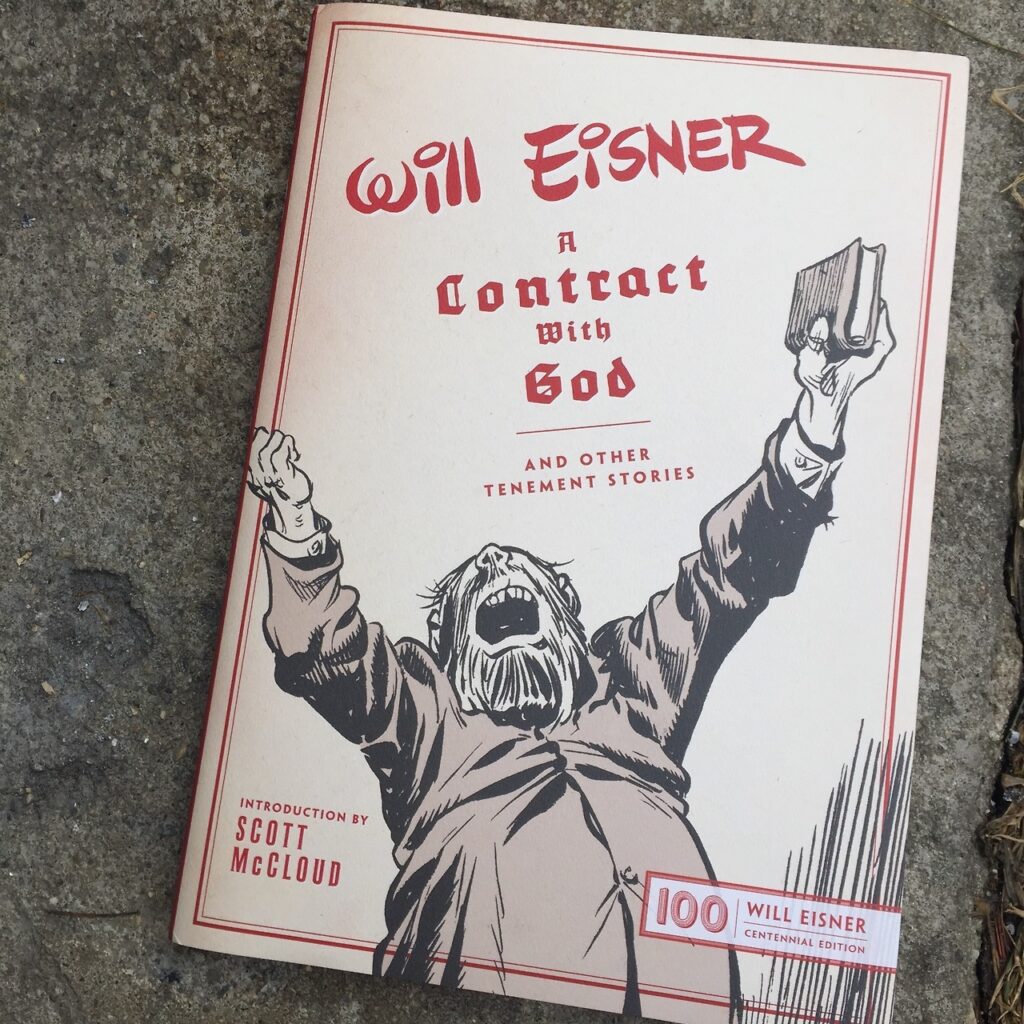
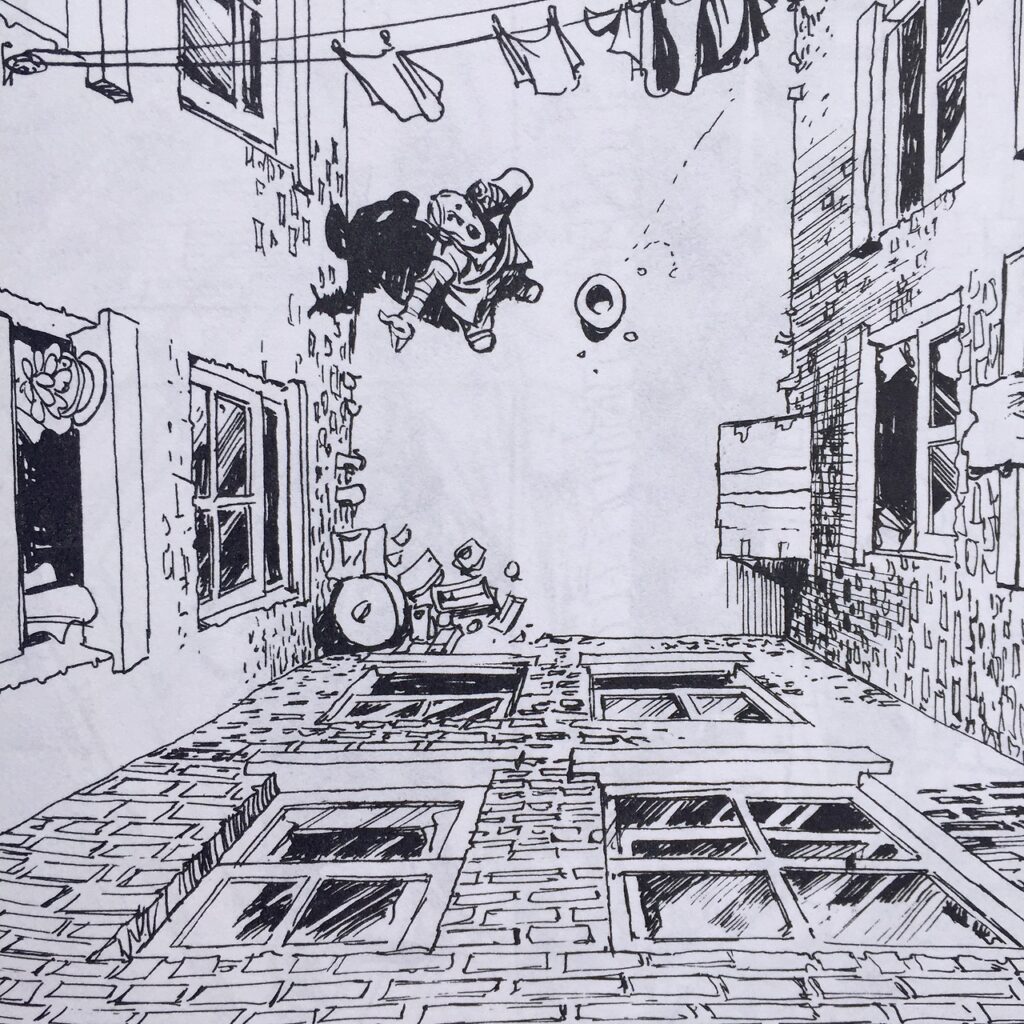
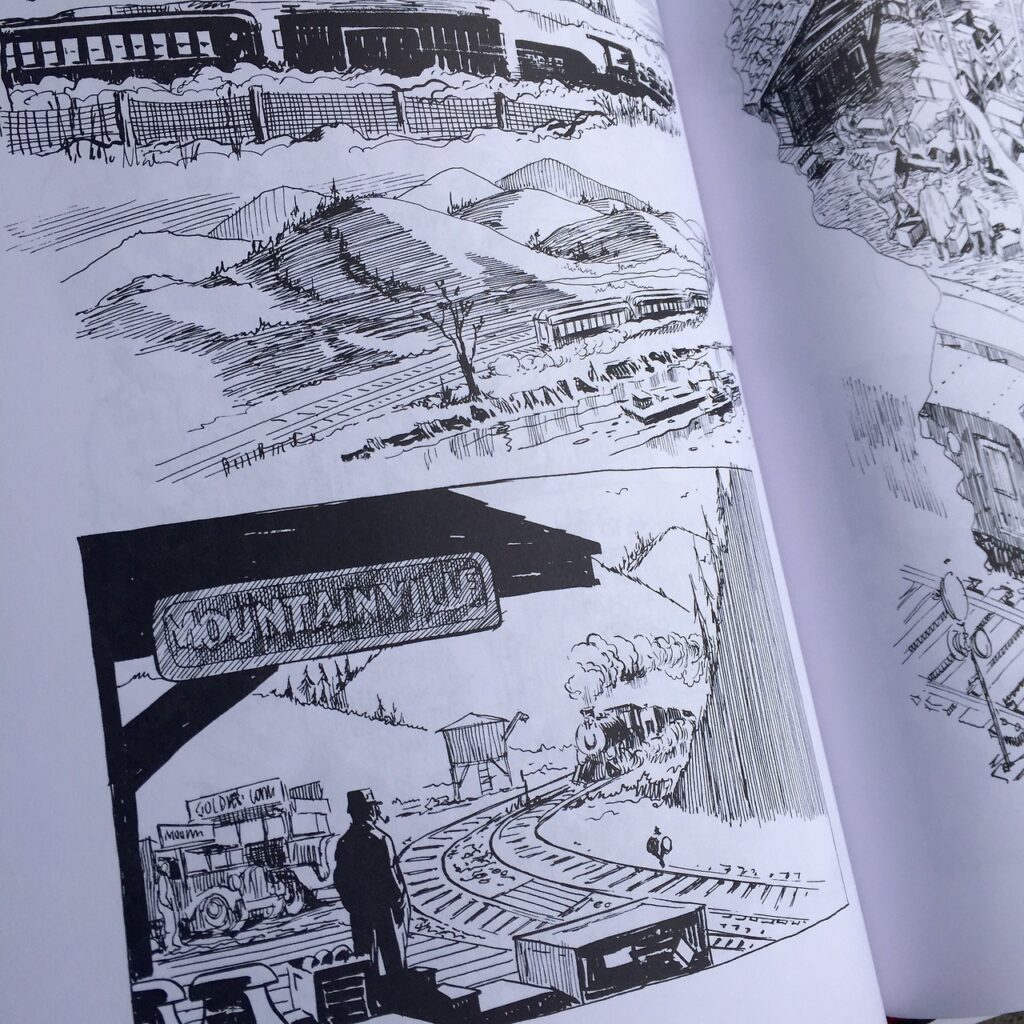





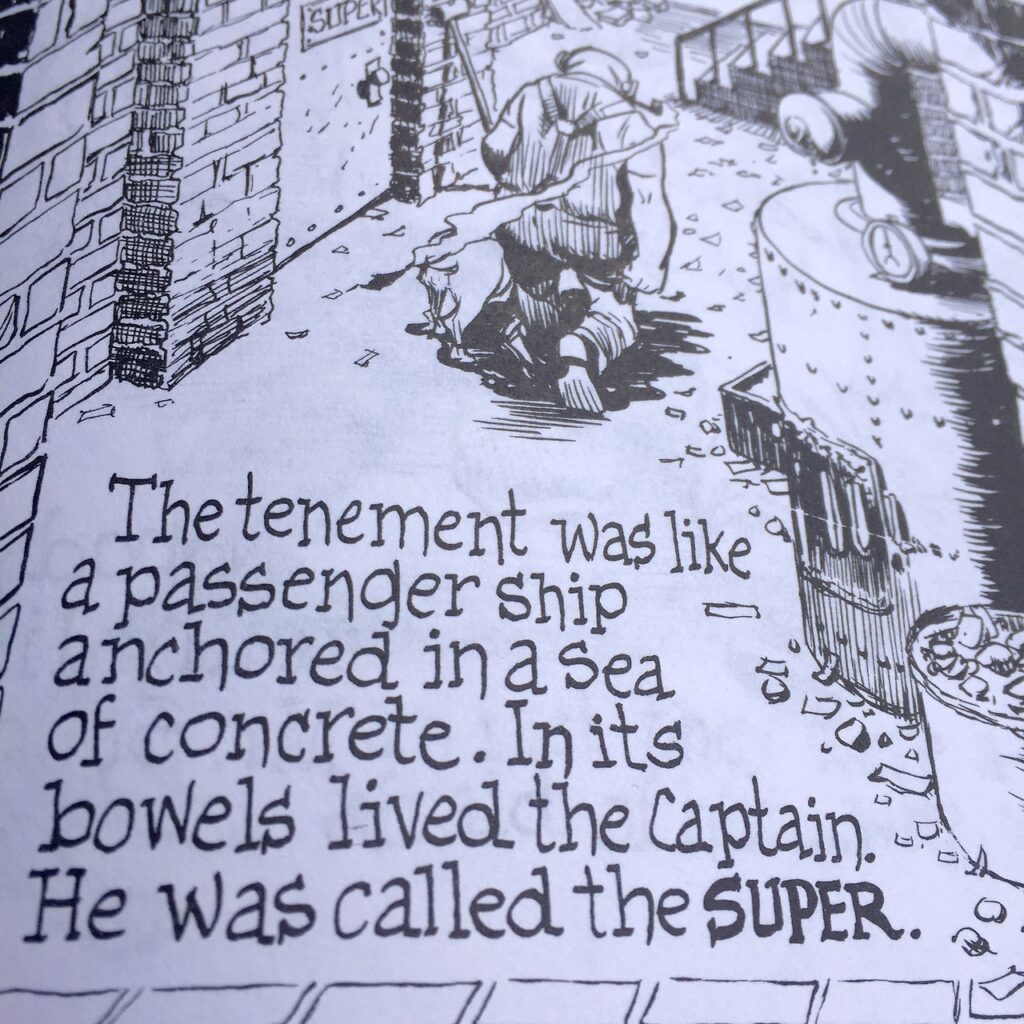
A Contract with God: And Other Tenement Stories
by Will Eisner, Scott McCloud
W.W. Norton & Company
2017, 224 pages, 7.3 x 0.9 x 10.3 inches, Hardcover
Originally published in 1978, Will Eisner’s A Contract With God “existed in its own continuum, patiently waiting for the rest of its kind to quietly arrive…” says Scott McCloud in his introduction to the hardcover edition, released in celebration of what would have been Eisner’s centennial year. McCloud’s intro, the publisher’s following “Brief History,” and Eisner’s own preface firmly contextualize the work and its creator within its time and the larger comics scene to which Eisner was so integral. With or without the history, it is nearly impossible to imagine a reader not being blown away by this collection.
A Contract With God explores the everyday extremes of human experience through the tenement building at 55 Dropsie Avenue. Residents strive, struggle, and schlep through the graphic short stories. Eisner explores the themes therein on multiple levels, with text and illustration that are cuttingly resonant. His characters fall in and out of faith in God, man, and love. Some are blindly optimistic and others rawly matter-of-fact in their realism. Some are both.
The stories are a fictional fleshing-out of Eisner’s life. The title story stems from his own experience of losing a child, The Street Singer and The Super from imagined realities of the characters in and around his own tenement, and my favorite, Cookalein, in some ways the most complex story in its interconnected and contrasting experiences of class, romance, and sex across its cast of characters, is what Eisner calls “a combination of invention and recall.” All the stories, in all the ways they are told, are violent, sad, intense, and beautiful.
– Mk Smith Despres
HOW TO SURVIVE IN THE NORTH — AN UNFORGETTABLE JOURNEY OF LOVE AND LOSS
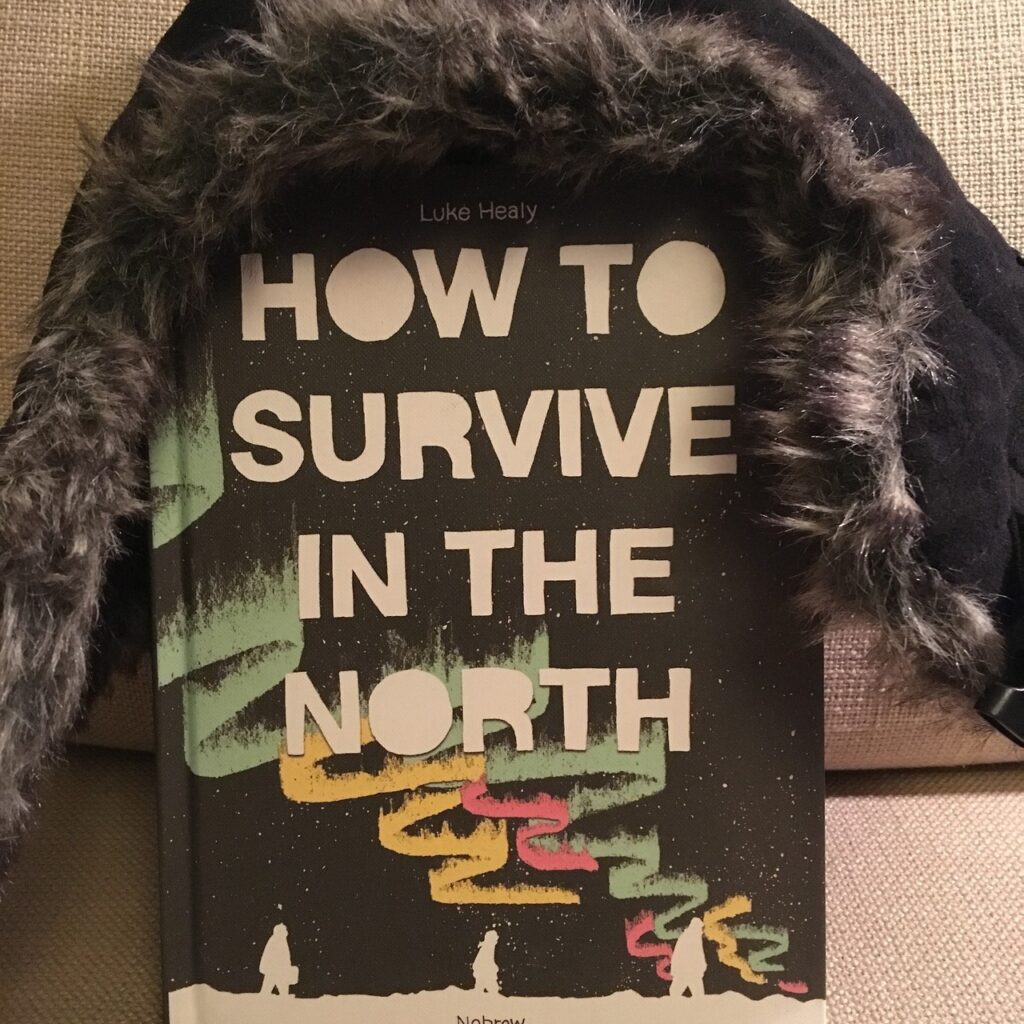


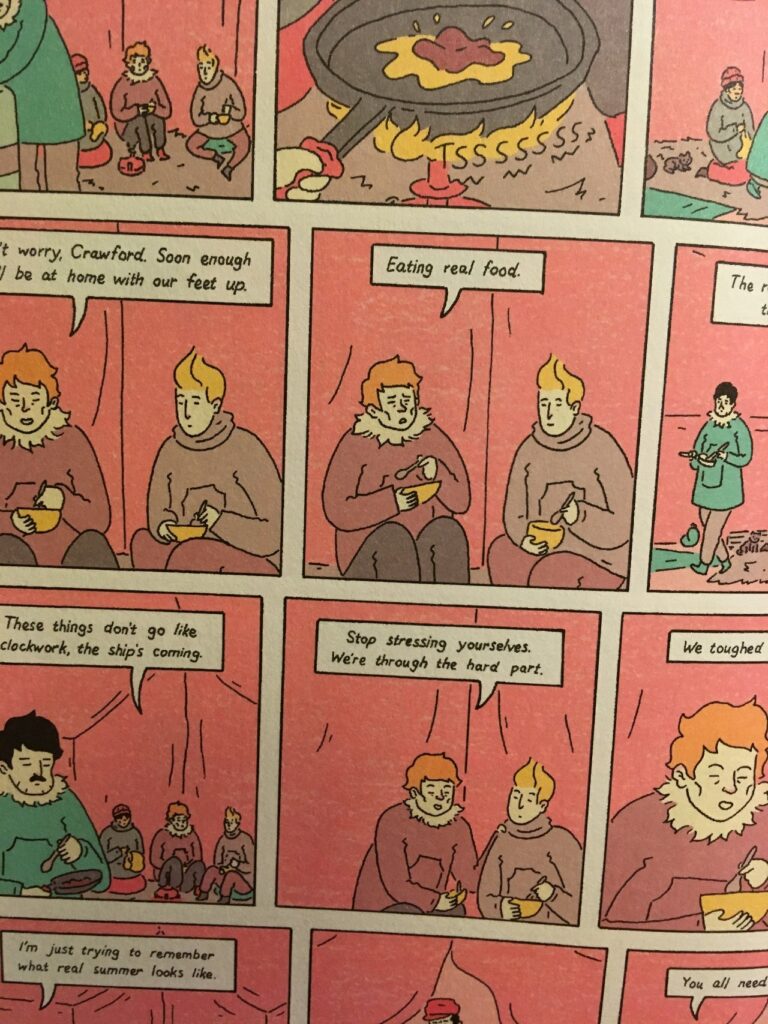



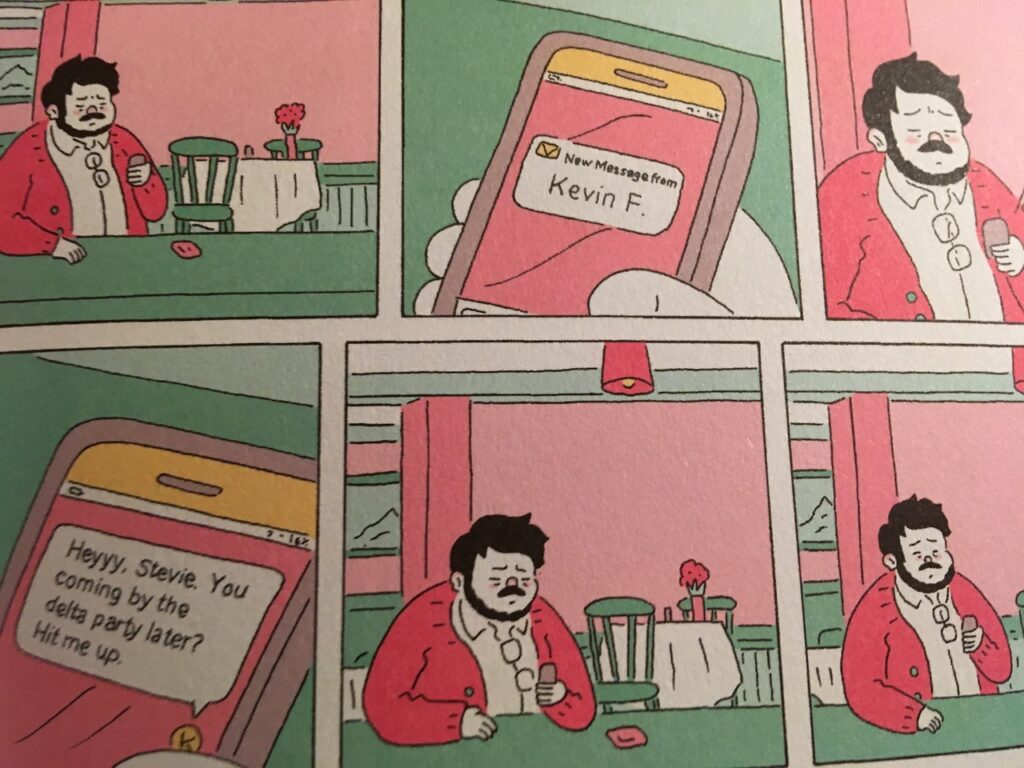

How to Survive in the North
by Luke Healy
Nobrow Press
2016, 192 pages, 6.6 x 1.1 x 9.0 inches, Hardcover
Ever read one of those books that has you running to Google immediately after finishing it, to find out as much as possible about the subject matter? This is one of those books. The two real-life stories it tells are so compelling that I had to learn more about these people.
“These people” are Robert Bartlett, who captained an Arctic expedition in 1913; and Ada Blackjack, an Inuit seamstress who joined an ill-equipped journey to Siberia in 1921. These journeys were dramatic, with deception, danger, isolation, and illness. The survival stories Healy retells are astonishing. Readers will witness the slow encroachment of scurvy, the desolation of Arctic landscapes, and the different forms that heroism can take.
By comparison, the third storyline — a fictional account of a disgraced professor in the modern day, who becomes fixated with Bartlett’s and Blackjack’s stories — just can’t hold as much interest.
The artwork is deceptively simple, with unfussy lines and a restricted, distinctive color palette of pale yellows, pinks, and greens. These colors create, with surprising subtlety, a mood of mounting desperation.
Fascinating history, check. Unusual characters, check. Natural settings and a color scheme ripe for cinematography, check and check. Someone turn this book into a movie already!
– Christine Ro
05/7/2406 May 2024
Backyard Chickens
Tools for Possibilities: issue no. 85
Once a week we’ll send out a page from Cool Tools: A Catalog of Possibilities. The tools might be outdated or obsolete, and the links to them may or may not work. We present these vintage recommendations as is because the possibilities they inspire are new. Sign up here to get Tools for Possibilities a week early in your inbox.
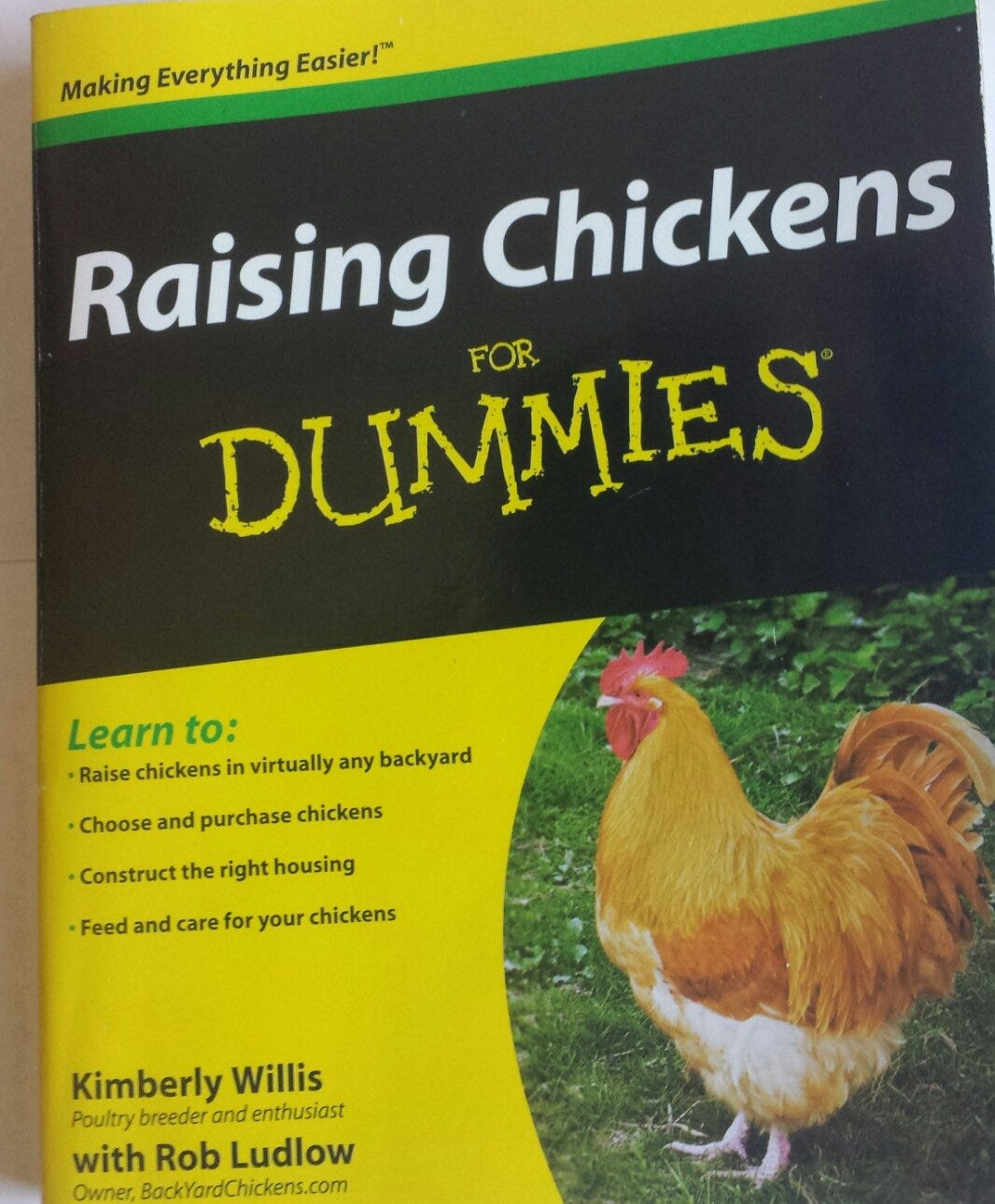
Best for backyard beginners
A few years ago we decided to join the growing backyard chicken movement. We knew zero about chicken raising. We were interested in keeping a handful of hens for eggs, so we didn’t want info on raising flocks of them (how many eggs can you eat a day?). I read every book for backyard beginners I could find, and after studying ten of them, the one that was most helpful to us was Raising Chickens for Dummies. It did the best job of anticipating our questions for a low-rent minimal approach. For instance, we had no desire to be cleaning chicken-shit every week, and we opted for deep bedding in the coop, a tip suggested by the book.
We’ve had chickens for two years now, and the book is still answering questions. The author runs a website, Back Yard Chickens, that has very active forums where you can ask other backyarders questions not found in his book. The site’s albums of photos of homemade coops proudly posted by members is very helpful and inspirational.
If you decide to graduate to larger flocks I would point you to the previously recommended book Storey’s Guide to Raising Chickens, which is extremely comprehensive, but often more than a beginner needs.
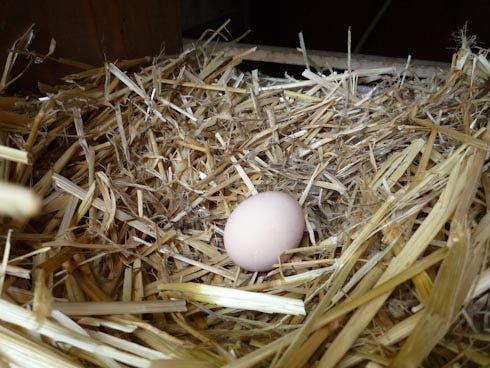
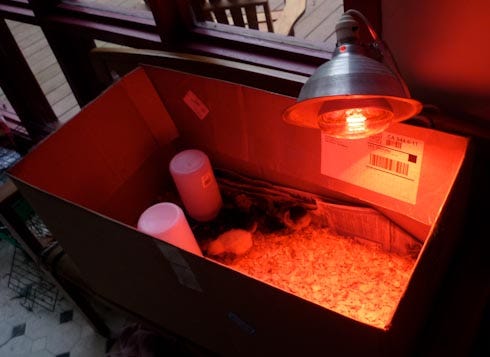
BTW, I was initially skeptical I would be able to tell a difference with backyard eggs, but it’s true. Backyard eggs do taste better; they are more…well…eggy. However, they won’t be cheaper, even if you don’t count your time. We kept our initial costs down by constructing a coop from scraps from a building site in the neighborhood (after asking permission). We had to buy the screening, which is double layered at the bottom (another book tip) because we have pretty serious predators around. We installed the previously reviewed automatic watering dish from the mail-order hatchery McMurray, which means that overall, the five chickens are very low maintenance. — KK
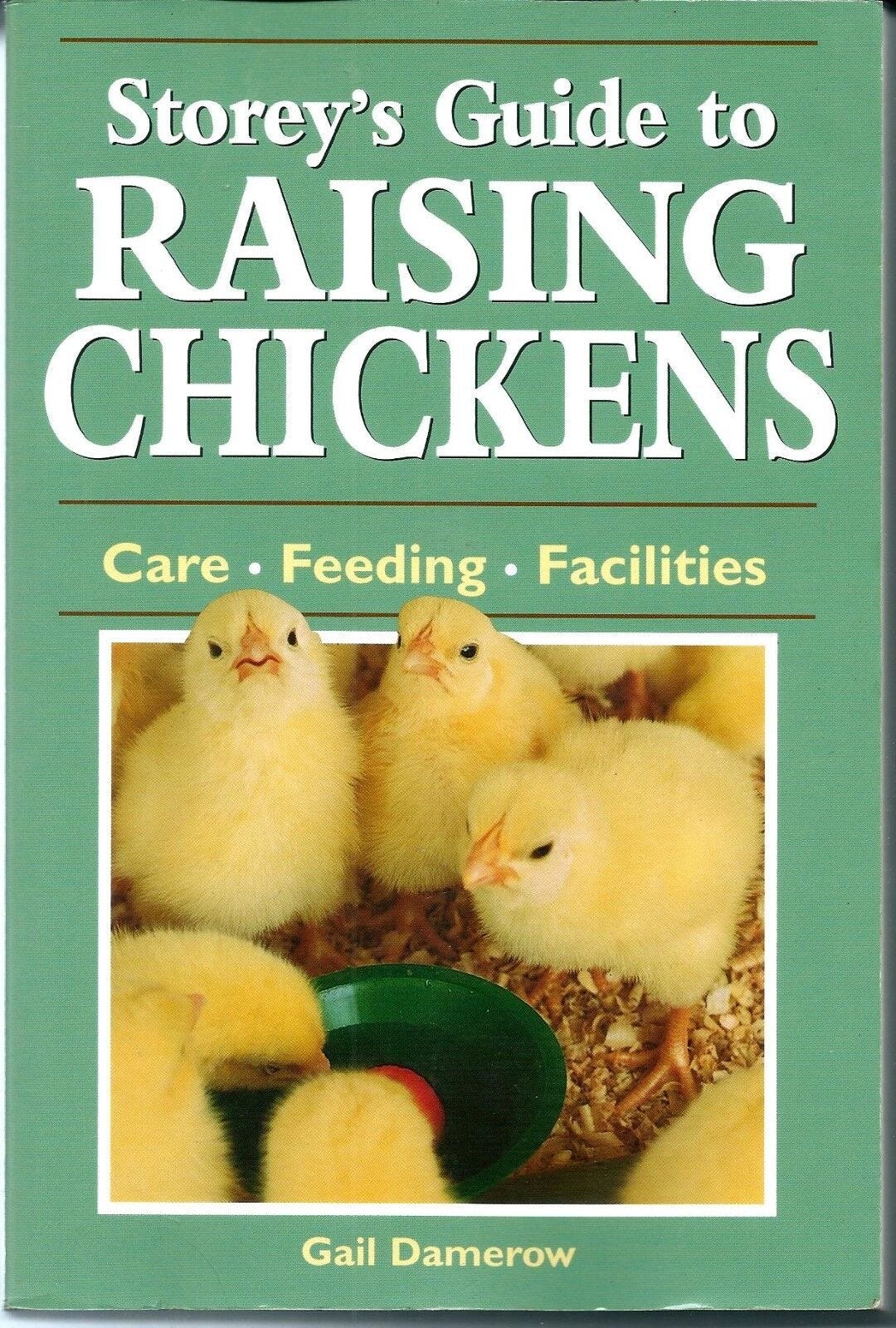
Classic how-to
Storey’s Guide to Raising Chickens
I’m not convinced you need a how-to book to raise chickens; they’re pretty resilient and will eat damned near anything and still lay eggs. But the best reference guide we have is the Storey’s Guide to Raising Chickens by Gail Demerow. Easy to read, full of information, and covers the whole range from hatching to keeping layers to raising meat birds to dealing with problems. — Mike Gunderloy
- The standard catching hook consists of a 30-inch (75cm) length of 8-gauge (4mm) wire bent at one end into a hook and firmly attached at the other end to a wooden rake or broom handle.
- Scratch can be used to trick chickens into stirring up their coop’s bedding to keep it loose and dry.
Toss a handful over the litter once a day (traditionally late in the afternoon when birds are thinking of going to roost) and your chickens will scramble for it. - Depending on the weather and on the bird’s size, each chicken drinks between 1 and 2 cups (237-474 ml) of water each day. Layers drink twice as much as nonlayers. In warm weather, a chicken may drink two to four times more than usual.
Chicks by mail
We’ve been buying baby chicks by U.S. mail from Murray McMurray Hatchery for 30-plus years. We’ll get a call from the postmaster, sometimes a bit flustered, because there’s a box there with peeping chicks awaiting pick-up. We’ll go get them and set them up with a light and feed and water, and lo and behold in three months we’ll have laying hens.
Minimum order is 25, so the chicks can warm each other in transit. We raise all of them and when they are teenaged, give or sell to neighbors. Raising 25 is no sweat.
Why get chickens by mail and not from your local feed store? McMurray has been in business for 90 years and their birds are of excellent stock. Lots of varieties to choose from. We’ve had not only Rhode Island Reds, Partridge Rocks and Auracanas for steady egg production, but exotics such as Cochins and Polish, as well as meat birds. They’ve all been top quality.
Get Murray’s hard copy catalog if you want to start a flock. Wonderful to look through. A few tips:
1. A dozen hens will give you plenty of eggs for you and your neighbors.
2. If you want fertile eggs, plan on ending up with one rooster for every dozen hens.
3. In more urban areas, get 4 or 5 hens, no rooster.
Once you have your own fresh eggs, you’ll never want store eggs again. — Lloyd Kahn

- Red Cap
This Old English Breed with reddish brown feathers tipped with black spangles has a large rose comb covered with prominent points. They are white skinned and lay tinted eggs. Chicks (picture above) are a light reddish tan with black speckles and some stripes.

- Egyptian Fayoumis
These small, active, lovely chickens have been raised along the Nile River in Egypt for centuries, and even though quite common there, are practically unknown in this country. We got our start of this very rare breed from one of the state universities whose poultry department was using them for special studies in genetics. No other breed matures quite so quickly as these do and the young pullets are apt to start laying their small tinted white eggs at 4 to 4-1/2 months while the cockerels will start to crow at an unbelievable 5 to 6 weeks. They are attractively marked with silvery white hackle and white bars on black background throughout the body plumage. Leg color can be either willow green or slate blue. Baby chicks are highly colored in brown, black, and white markings on the back and a brownish purple head color.
05 May 2024
Retro Recomendo: Music
Recomendo - issue #408
Our subscriber base has grown so much since we first started seven years ago, that most of you have missed all our earliest recommendations. The best of these are still valid and useful, so we’re trying out something new — Retro Recomendo. Once every 6 weeks, we’ll send out a throwback issue of evergreen recommendations focused on one theme from the past 7 years.
World Radio
Radio Garden is a website that presents you with a spinnable globe of the Earth. The green dots represent radio stations. Rotate the globe, click a dot and you are suddenly listening to live radio in that part of the world. Right now I’m listening to Radio Seaside Wave in Nakhodka, Russia. — MF
Exploratory music stream
For the past decade David Byrne, the legendary rock musician, has operated his own “radio station,” which is really the curated playlist of his own musical explorations. Every month on his website David Byrne Radio, Byrne streams another 100-minute loop of new, old, classic, weird, wonderful, surprising, themed music he’s discovered and loves. He writes a short introduction, and supplies the full playlist. I’ve discovered (and bought) a lot of great music I first heard here. (In Nov 2018 he streamed a notable playlist of eternal protest songs.) — KK
Time machine for music
If you pick a year from your past (1951-2015), The Nostalgia Machine will warp you back musically and link you to videos of the top Billboard Hits of that time. 1996 takes me back to sixth grade and TLC and Alanis Morissette and a lot of weekend nights spent at the rollerskating rink. — CD
Best meditation music
There’s rarely a day that goes by that I don’t listen to my Meditative Mind: Music & Sleep app. There are hundreds and hundreds of soothing and immersive soundscapes, chants, mantras, nature sounds and world music to choose from. I use it when I need to focus, meditate or sleep. The app is free to download and try out, but I happily pay the annual subscription for access to their full library, unlimited downloads and an ad-free experience. There is also a YouTube channel with lots of long-format music tracks added almost daily. — CD
X-ray into music
You know about Song Exploder, yes? It’s this amazing podcast that takes one well-known song each week and explodes it into its separate components. The musicians who wrote and perform the song take it apart track by track, sometimes beat by beat, explaining what they were thinking as they created the pieces: what challenges and dead-ends they met along the way, how the song changed as they worked on it, and why they like the final version. It’s the x-ray into music I always wanted. — KK
Enjoy the boss radio sound of KHJ 93 Los Angeles
One of my favorite things about Quentin Tarantino’s Once Upon a Time… in Hollywood was listening to clips of 93 KHJ, a radio station that pioneered the “boss radio” sound in the 1960s. The DJs were all vocal virtuosos, and the most talented of the bunch was a guy by the name of “The Real Don Steele.” Almost all of these broadcasts have been lost to time, but fortunately, some people recorded KHJ on their tape recorders in the 1960s, and the recordings found their way to the Internet. The Internet Archive has a couple of recordings from the 1960s of Steele’s show on KHJ. Here’s another, and another (with other KHJ DJs, too). If this kind of thing interests you, you can dig up more by searching “khj airchecks.” — MF
05/5/24ALL REVIEWS
 05/3/24
05/3/24
Gar’s Tips & Tools – Issue #177
Weekly-ish access to tools, techniques, and shop tales from the worlds of DIY
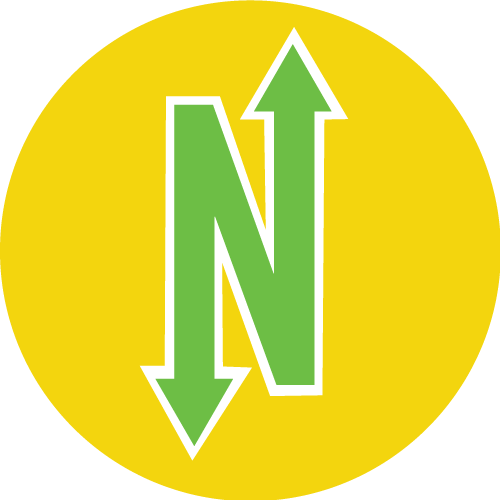 05/2/24
05/2/24
Hotels for Sale/Airline Points Devaluations/Attractive Cities for Living
Nomadico issue #102
EDITOR'S FAVORITES
COOL TOOLS SHOW PODCAST
WHAT'S IN MY BAG?
08 May 2024

ABOUT COOL TOOLS
Cool Tools is a web site which recommends the best/cheapest tools available. Tools are defined broadly as anything that can be useful. This includes hand tools, machines, books, software, gadgets, websites, maps, and even ideas. All reviews are positive raves written by real users. We don’t bother with negative reviews because our intent is to only offer the best.
One new tool is posted each weekday. Cool Tools does NOT sell anything. The site provides prices and convenient sources for readers to purchase items.
When Amazon.com is listed as a source (which it often is because of its prices and convenience) Cool Tools receives a fractional fee from Amazon if items are purchased at Amazon on that visit. Cool Tools also earns revenue from Google ads, although we have no foreknowledge nor much control of which ads will appear.
We recently posted a short history of Cool Tools which included current stats as of April 2008. This explains both the genesis of this site, and the tools we use to operate it.










